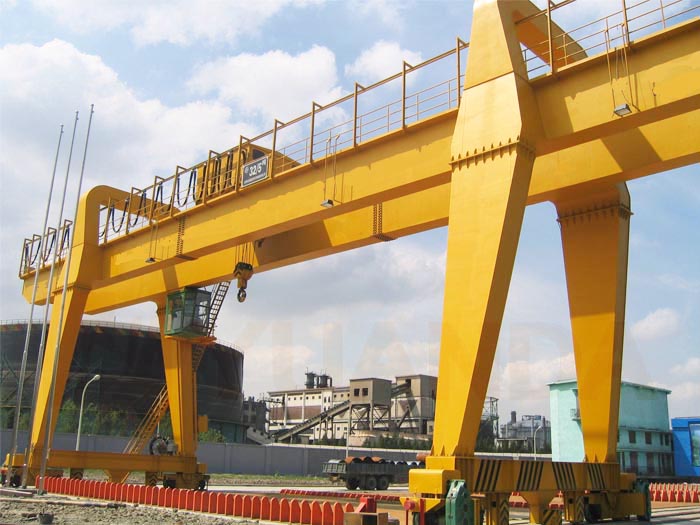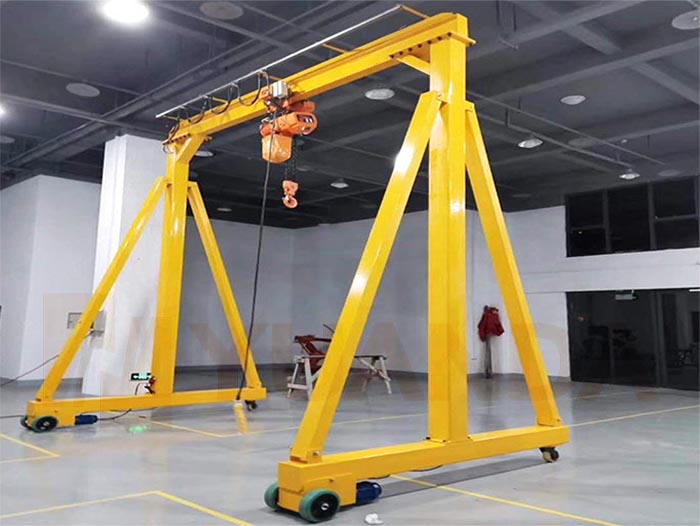What is a Gantry Crane?
An electric gantry crane is an overhead crane that has one or two beams supported by freestanding legs and moves on wheels, a track, or rail system carrying a bridge, trolley, and electric hoist. Gantry cranes are usually considered when there is a reason not to install an overhead runway system. Workshops, warehouses, freight yards, steel mills, railroads, power plants and shipyards use gantry cranes as their overhead lifting solution as a variation of overhead cranes or bridge cranes.
Gantry cranes with electric hoists are versatile material handling solutions designed to handle both small light duty and heavy-duty loads. The rated loading capacity can range from 2 ton, 3 ton, 25 ton up to 100 ton. Their variety allows for customization to fit various lifting applications. The main advantage of gantry cranes is their ability to lift loads efficiently and safely, which enhances productivity and reduces time and costs.

Gantry cranes are categorized into single and double girder types. Single girder gantry cranes are used for smaller weight lifting applications, such as 5 ton gantry crane, 10 ton gantry crane, 20 ton gantry crane; while heavy duty double girder gantry cranes are designed for high-capacity and more demanding tasks, such as 50 ton gantry crane, 60 ton gantry crane, 150 ton gantry crane and 200 ton gantry crane. Double girder designs, with their greater capacity, structure and performance capabilities, tend to be more expensive.
While the common design features an “A” frame, gantry cranes are also available with L-shaped and U-shaped legs. Regardless of the girder type, all industrial gantry cranes are engineered for heavy workloads and extended use, making them a practical choice for heavy lifting tasks.
These are typically used for an outdoor application or below an existing overhead bridge crane system. Unlike a bridge crane, a gantry crane does not need to be tied into a workshop building’s support structure—eliminating the need for permanent runway beams, rails and support columns. In some cases, this can result in a significant reduction in material costs and can be a more cost-effective solution compared to a similarly specified bridge crane.
The lifting capacity of gantry cranes can range from a few hundred pounds to several hundred tons. Larger gantry systems may run on a rail or track embedded in the ground, typically in a straight line in a dedicated work area. They are also named as rail mounted gantry crane. Small portable gantry crane systems run on castors or motorized wheels and can be moved around in a facility for maintenance or light fabrication work. These light models can also be made as aluminum gantry crane, which features anti-corrosion design. All of them offer an efficient and cost-effective solution for lifting and moving equipment, materials, and tools of varying sizes and weights.

Gantry cranes are utilized in mechanical workshops, warehouses, scrap yards, automotive assembly lines, paper mills, construction sites, shipping docks, container yards and railroad yards. Outdoor models are equipped with weather protection features such as wind proofing, rain covers, and lightning protection. Additionally, mobile gantry cranes can be designed with fixed or adjustable height and span to meet the specific requirements of different facilities.
At YUANDA, we build custom overhead gantry crane systems. We have over 20 years of experience in the gantry crane industry and can build custom lifting solutions ranging from light-duty economical cranes to large-capacity, high-duty cycle cranes. If you’re interested in scheduling a consultation of your project, please contact one of our experts now.